
Google Cloud Makes Good on Promise to Add Nvidia P100 GPUs
September 21, 2017
Google has taken down the notice on its cloud platform website that says Nvidia Tesla P100s are “coming soon.” That's because the search giant has announced Read more…

Amazon Web Services Spotlights HPC Options
August 11, 2015
Despite high initial interest, HPC in the cloud never achieved significant adoption levels, mainly being relegated to low-hanging "pleasingly parallel" fruit a Read more…

Leveraging Cloud on Your Own Terms
September 15, 2014
Many IT organizations are seeking a new approach to the data management challenges presented when using multiple clouds. In particular, they want an approach th Read more…

Free Market HPC Cloud In Development
August 18, 2014
Distributed computing has undergone many permutations, from its roots in grid computing to support large scientific endeavors to Sun-style utility computing, to Read more…

Overcoming the Cloud Security Barrier for Financial Services
May 10, 2013
The private industry least likely to adopt public cloud services for data storage are financial institutions. Holding the most sensitive and heavily-regulated of data types, personal financial information, banks and similar institutions are mostly moving towards private cloud services – and doing so at great cost. Read more…

Windows Azure Ready to Take on AWS
April 17, 2013
After a lengthy incubation phase, Microsoft is finally ready to release its IaaS product into the wild. AWS, look out. Read more…

The Week in HPC Research – 03/14/2013
March 14, 2013
The top research stories of the week include the 2012 Turing Prize winners; an examination of MIC acceleration in short-range molecular dynamics simulations; a new computer model to help predict the best HIV treatment; the role of atmospheric clouds in climate change models; and more reliable HPC cloud computing. Read more…

Redshift, New Instance Types, Price Cuts and More at AWS Re: Invent
December 4, 2012
AWS used its first ever customer and partner conference, AWS re: Invent, held last week in Las Vegas, as a launch pad for some major company news. During their respective keynotes, AWS Senior Vice President Andrew Jassy revealed a brand new data warehouse service, AWS Redshift, and another price cut for the S3 storage service, while Amazon.com CTO Werner Vogels announced two super-sized EC2 Instance Types, and another new service, the AWS Data Pipeline. Read more…

- Click Here for More Headlines

Whitepaper
How Direct Liquid Cooling Improves Data Center Energy Efficiency
Data centers are experiencing increasing power consumption, space constraints and cooling demands due to the unprecedented computing power required by today’s chips and servers. HVAC cooling systems consume approximately 40% of a data center’s electricity. These systems traditionally use air conditioning, air handling and fans to cool the data center facility and IT equipment, ultimately resulting in high energy consumption and high carbon emissions. Data centers are moving to direct liquid cooled (DLC) systems to improve cooling efficiency thus lowering their PUE, operating expenses (OPEX) and carbon footprint.
This paper describes how CoolIT Systems (CoolIT) meets the need for improved energy efficiency in data centers and includes case studies that show how CoolIT’s DLC solutions improve energy efficiency, increase rack density, lower OPEX, and enable sustainability programs. CoolIT is the global market and innovation leader in scalable DLC solutions for the world’s most demanding computing environments. CoolIT’s end-to-end solutions meet the rising demand in cooling and the rising demand for energy efficiency.
Download Now
Sponsored by CoolIT
Whitepaper
Transforming Industrial and Automotive Manufacturing
Divergent Technologies developed a digital production system that can revolutionize automotive and industrial scale manufacturing. Divergent uses new manufacturing solutions and their Divergent Adaptive Production System (DAPS™) software to make vehicle manufacturing more efficient, less costly and decrease manufacturing waste by replacing existing design and production processes.
Divergent initially used on-premises workstations to run HPC simulations but faced challenges because their workstations could not achieve fast enough simulation times. Divergent also needed to free staff from managing the HPC system, CAE integration and IT update tasks.
Download Now
Sponsored by TotalCAE
Advanced Scale Career Development & Workforce Enhancement Center
Featured Advanced Scale Jobs:
HPCwire Resource Library
HPCwire Product Showcase
© 2024 HPCwire. All Rights Reserved. A Tabor Communications Publication
HPCwire is a registered trademark of Tabor Communications, Inc. Use of this site is governed by our Terms of Use and Privacy Policy.
Reproduction in whole or in part in any form or medium without express written permission of Tabor Communications, Inc. is prohibited.
























